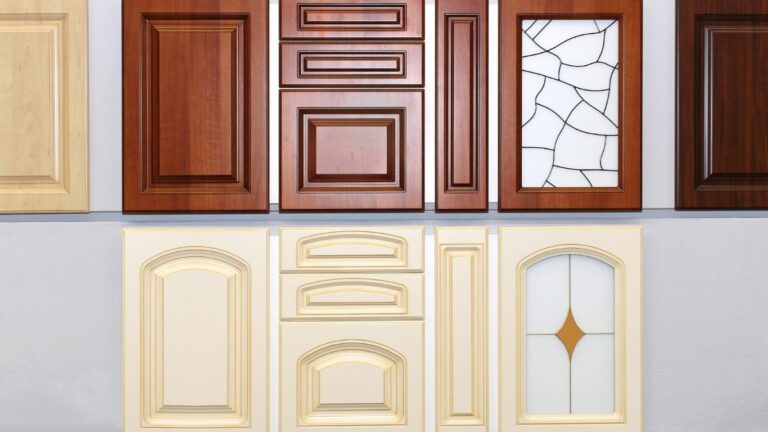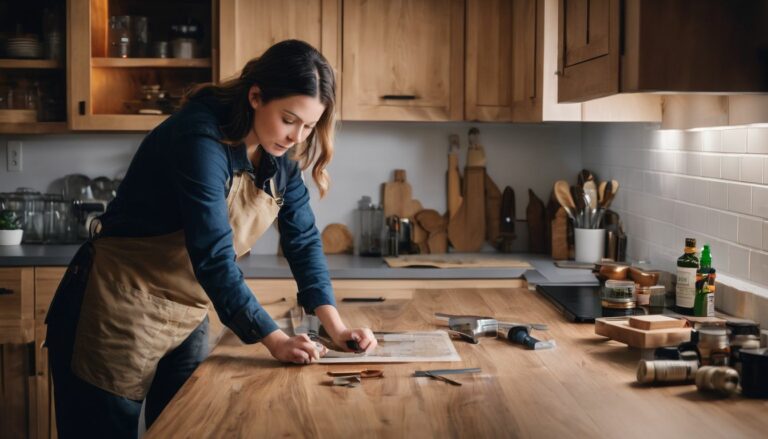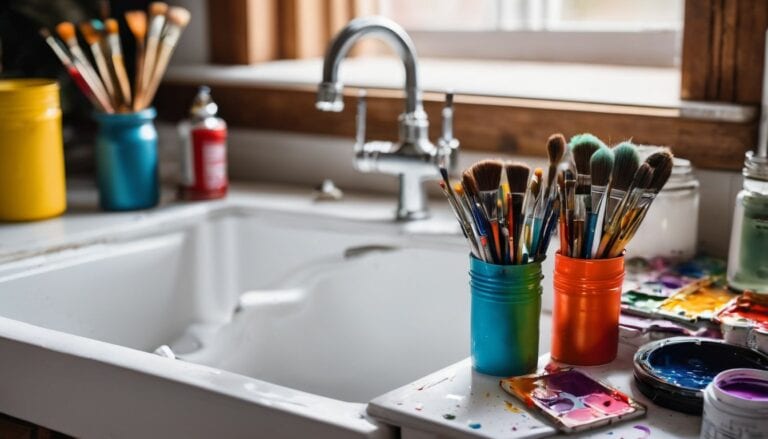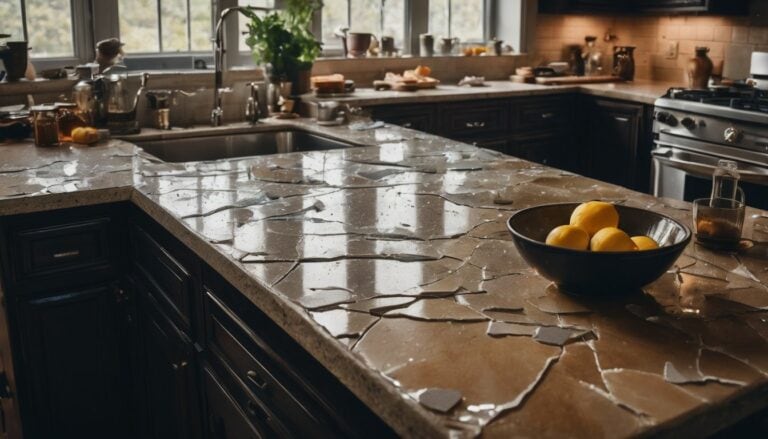Prevent Cracks: Discover What Causes Kitchen Tiles to Fail
Those stubborn cracks that emerge on your beautiful kitchen tiles can be a real nuisance. Not only do they disrupt the harmony of your color palette, but also pose danger due to potential tripping or slipping hazards.
Like you, I’ve encountered this exasperating issue and combed through countless resources to find reasons behind these cracks and ways to prevent them from happening in the first place.
In this blog post, we’re going to dive headfirst into why our beloved kitchen tiles succumb to cracking, explore proactive measures we can employ for their protection, and even learn how we could fix them if they somehow end up cracked anyway.
Buckle up; it’s time we save our cherished kitchen tiles from unwanted harm!
Key Takeaways
- Kitchen tiles can crack due to falling objects, heavy items, cracked concrete substrate, tiling over control joints, and improperly spaced joists.
- To prevent tile cracks, use proper installation techniques, such as preparing the surface and using the right adhesive. Also, make sure to use a suitable underlayment and avoid forceful impacts or mishandling of heavy objects.
- Building movement can also cause tile cracking due to deflection and vertical movement or expansion and contraction from side-to-side movement.
- A strong and stable substrate is important in preventing tile cracks. Proper curing of concrete and using sufficient underlayment are key factors in maintaining the durability of kitchen tiles.
Understanding Why Kitchen Tiles Crack

Kitchen tiles can crack due to various reasons, such as falling objects and accidents, heavy items and weight, cracked concrete substrate, tiling over control joints, improperly spaced joists, or the use of sub-standard tiles.
Falling objects and accidents
In my kitchen, I’ve seen how falling objects and accidents cause tiles to crack. It’s clear that the surface of tiles is fragile. A big pan or a sharp knife hits the floor — boom! There’s a dent or even worse, a break in your lovely tile.
Dense things falling on it can lead to ugly cracks across the floor as well. Even small mishaps like these add up over time and create breaks you can’t ignore anymore. Many times, if just one tile has damage, then something heavy probably fell on it accidentally.
In short, everything from tiny slips to big blunders make tiles less perfect every day.
Heavy items and weight
Heavy items and their weight can harm your kitchen tiles. Tiles are not made to hold too much weight. If you put a lot of heavy things on them, they might crack. The load capacity of each tile is not the same.
Some tiles can take more weight than others.
Kitchens pose a higher risk for tile breakage because we often drop heavy pots or pans by accident. The impact from these falls tests the strength and durability of our tiles. We need to care for them well if we want to keep them looking good as new! Be aware that heavy items in the kitchen can be hard on your floor tiles’ fragility.
Cracked concrete substrate
Concrete cracks in the kitchen floor can cause tile cracks. This happens when the concrete underneath was not made well or dried right. Cracks in this base layer, called a substrate, lead to breaks in the tiles above.
A control joint might stop this damage from happening. When it’s put into the concrete right at its making time, it helps stop cracks from growing big and hurting your tiles. But, if lots of your tiles show cracks all over them, that means there is a big crack under them on the concrete layer below too!
Tiling over control joints
Tiling over control joints can be a cause of kitchen tiles cracking. Control joints are important because they allow for the natural expansion and contraction of the tile surface. When you tile over these joints without accounting for movement, it puts stress on the tiles and can lead to cracks.
This is especially common in new build developments where proper installation techniques may not have been followed. To prevent this issue, it’s recommended to use crack isolation membranes or anti-fracture membranes when tiling over control joints.
These materials help absorb movement and reduce the risk of tile cracking.
Improperly spaced joists
Improperly spaced joists can cause kitchen tiles to crack. When the spacing between the joists is not done correctly, it can lead to movement and flexing of the floor. This movement puts stress on the tiles, making them more prone to cracking.
Additionally, if the tiles are located mid-span between two joists, they have less support which further increases the risk of cracking. It’s important to ensure that joists are properly spaced and securely installed to prevent this common problem in tile installation.
By doing so, you can help maintain the structural integrity of your kitchen flooring and prevent future issues with cracked tiles caused by improperly spaced joists. Remember, a strong foundation is key for a durable and long-lasting tiled floor in your kitchen!
Use of sub-standard tiles
Inferior or sub-standard tiles can be a major cause of kitchen tile cracking. These tiles are often made with poor quality materials and may not meet the necessary standards for durability and strength.
When you use these subpar tiles in your kitchen, they are more likely to crack under the weight of heavy appliances or furniture. The reduced strength of these tiles makes them unable to withstand the pressure, causing cracks to form.
It’s important to choose high-quality tiles that meet the proper standards to prevent this issue and ensure a longer lifespan for your kitchen flooring.
Preventive Measures for Avoiding Tile Cracks

To avoid tile cracks, proper tile installation techniques should be followed, suitable underlayment should be used, forceful impacts should be avoided, and heavy objects should be handled and placed carefully.
Proper tile installation techniques
Proper tile installation is crucial in preventing cracks. Here are some techniques to ensure a strong and durable tile installation:
- Prepare the surface: Before installing tiles, make sure the surface is clean, level, and free from any debris. This will provide a solid foundation for the tiles.
- Use the right adhesive: Use an adhesive that is appropriate for your specific type of tile and substrate. Using the wrong adhesive can lead to poor adhesion and eventual cracking.
- Apply even pressure: When laying the tiles, apply even pressure to ensure they are properly bonded to the substrate. This will help prevent any weak spots where cracks might occur.
- Allow for expansion joints: Leave small gaps between tiles to allow for natural expansion and contraction caused by temperature changes. These expansion joints help reduce stress on the tiles and minimize the risk of cracking.
- Grout properly: Properly fill in the gaps between tiles with grout, ensuring that it is evenly distributed and fully covers all joints. This will help provide additional support to the tiles and prevent them from shifting or cracking.
Use of suitable underlayment
Using a suitable underlayment is really important for preventing tile cracks in your kitchen. When there are gaps or voids between the tile and the surface, it can weaken the tiles and make them more likely to crack.
That’s why proper subfloor preparation is necessary before installing tiles. By using anti-fracture membranes or crack isolation membranes, you can help prevent those cracks from happening.
So, make sure to choose a good underlayment that provides support and eliminates any gaps during installation because it will strengthen your tile installation and protect against potential damage.
Avoiding forceful impacts
To prevent tile cracks caused by forceful impacts, it’s important to take some preventive measures. One effective way is to use an anti-fracture or crack isolation membrane during the tile installation process.
This membrane helps absorb impact and prevents cracks from forming on the tiles. Another important step is to securely bond the tiles to the surface using a suitable adhesive. This ensures that they are well-protected and less likely to crack when something heavy is dropped or falls on them.
It’s also advisable to place protective padding or felt pads under heavy furniture or appliances to minimize the risk of forceful impacts causing damage. By taking these precautions, you can greatly reduce the chances of your kitchen tiles cracking due to forceful impacts.
Careful handling and placement of heavy objects
When handling heavy objects in the kitchen, it’s important to be careful and mindful of how you place them. Here are some tips to help prevent tile cracks:
- Lift heavy objects instead of dragging them across the floor.
- Place a protective barrier, like a mat or rug, under heavy furniture or appliances to distribute the weight.
- Avoid dropping or slamming heavy items onto the tiled floor.
- Use furniture pads or felt protectors on the legs of chairs and tables to prevent scratches and pressure points.
- Consider using a dolly or furniture sliders when moving large items to reduce the risk of impact.
The Role of Building Movement in Tile Cracking
Building movement plays a significant role in causing tile cracking, as it can lead to deflection and vertical movement, as well as expansion and contraction from side-to-side movement.
Deflection and vertical movement
Deflection and vertical movement can be a major cause of tile cracking in your kitchen. When the building experiences structural stress or movement, it puts pressure on the tiles, causing them to crack under the strain.
This can happen when there is deflection control or vertical displacement in the subfloor joints, which then transfers to the tiles above. The weight of heavy furniture or appliances can also contribute to this problem by putting additional stress on the tiles.
So, if you notice cracks in your kitchen tiles, it’s important to consider these factors and take preventive measures to avoid further damage.
Expansion and contraction from side-to-side movement
Expansion and contraction from side-to-side movement can cause tiles to crack. When a building experiences structural movement, such as when the ground shifts or settles, it can put stress on the tiled surfaces.
This stress can lead to cracks in the tiles. Additionally, control joints in concrete floors, which are designed to allow for movement, can also be a source of tile cracking. The expansion and contraction that occurs from side-to-side movement can create pressure on the tiles, causing them to crack.
It’s important to consider these factors when installing tiles and choose materials that can withstand this type of movement.
The Importance of a Strong and Stable Substrate
A strong and stable substrate is crucial for preventing tile cracking. Proper curing of the concrete ensures that it is solid and free from defects that could cause stress on the tiles.
Additionally, using a sufficient underlayment helps to absorb any movement in the floor, reducing the risk of cracks in the tiles above.
Proper curing of concrete
Properly curing concrete is really important for preventing tile cracking. When concrete is properly cured, it continues to hydrate and gain strength over time. This helps to keep the volume stable and resistant to freezing, which can cause cracks in the tiles.
It’s important to wait for around 28 days for the concrete to fully cure before installing tiles. If the concrete isn’t cured properly, it can have excess moisture that causes hairline cracks in the tiles.
So, taking the time to properly cure the concrete ensures a strong and stable substrate, which is essential for preventing tile cracking.
The effect of deficient underlayment on tile cracking
Deficient underlayment can cause tiles to crack. When the underlayment, which is the layer beneath the tiles, is weak or insufficient, it doesn’t provide enough support and stability.
This means that when pressure or force is applied to the tiles, they are more likely to crack. Hairline cracks in tiles can also occur if the concrete underneath was not properly cured or if there is flexing in the underlayments and joists.
It’s important to have a strong and stable substrate to prevent tile cracking and maintain their durability.
How to Repair Cracked Tiles
To repair cracked tiles, start by removing the damaged tile using a chisel and hammer. Make sure to wear safety goggles and gloves during this process. Then, clean the area thoroughly and apply adhesive to the back of the replacement tile.
Press it firmly into place and use a grout float to fill in any gaps with matching grout. Allow the grout to dry completely before cleaning off any excess.
Replacing cracked tiles
If you have cracked tiles in your kitchen, here’s what you can do to fix them:
- Remove the damaged tile by carefully breaking it into smaller pieces and prying them out.
- Clean the area where the tile was using a mild detergent and water.
- Apply adhesive to the back of a new tile and carefully press it into place.
- Use a grout float to fill in the gaps between the tiles with grout.
- Wipe away any excess grout with a damp sponge.
Using filler materials for hairline cracks
I have found a solution for repairing hairline cracks in tiles. Here are the steps to use filler materials for this:
- Assess the size and extent of the hairline cracks in your tiles.
- Purchase an epoxy filler specifically designed for repairing tile cracks.
- Clean the cracked area thoroughly to remove any dirt or debris.
- Mix the epoxy filler according to the manufacturer’s instructions.
- Apply a thin layer of the filler onto the crack using a small putty knife or similar tool.
- Make sure to fill the crack completely, smoothing out any excess filler.
- Allow the filler to dry and cure as per the instructions provided.
- Once dry, gently sand down any rough edges or uneven surfaces created by the repair.
- Clean the area again to remove any dust or residue from sanding.
- Finally, apply a sealer over the repaired area to protect it and blend it with surrounding tiles.
Professional repair options for larger cracks
When dealing with larger cracks in kitchen tiles, it is important to seek professional repair options. Here are some ways professionals can help fix those cracks effectively:
- Filling the cracks with epoxy or acrylic grout: Professionals have the knowledge and tools to apply epoxy or acrylic grout to fill in and seal larger cracks.
- Removing and replacing the cracked tile: In some cases, the damaged tile may need to be completely removed and replaced with a new one. Professionals have the expertise to remove the damaged tile without causing further damage.
- Using a diamond blade for precision: To ensure a seamless replacement, professionals may use a diamond blade to cut out the cracked tile and surrounding grout before installing a new tile.
- Leveling the floor or substrate: Sometimes, uneven flooring or substrate can cause tiles to crack. Professionals can assess and level the floor or substrate to prevent future cracking.
Common Questions about Tile Cracking
Why do tiles crack even when installation guidelines are followed? Can temperature changes cause tile cracking?
Why are my tiles cracking despite following installation guidelines?
I followed all the installation guidelines, but still, my tiles are cracking. It can be frustrating when this happens. There could be a few reasons why your tiles are cracking despite following the guidelines.
One possibility is that there may have been some errors during the installation process. Another reason could be accidental damage caused by dropping heavy objects onto the tiles. Stress fractures from excessive pressure or impacts can also lead to tile cracks.
Additionally, if there are any issues with the subfloor, such as control joint problems or uneven surfaces, it can contribute to tile cracking as well. So even if you’ve followed all the guidelines, these factors might still cause your tiles to crack.
Can tiles crack due to temperature changes?
Yes, tiles can crack due to temperature changes. Extreme fluctuations in temperature can cause the materials used in tiles, such as terracotta, ceramic, and porcelain, to expand or contract rapidly.
This expansion and contraction can put stress on the tile surface, leading to cracks. To prevent this from happening, it is important to properly space expansion joints in tile floors.
These joints allow for some movement and relieve the pressure on the tiles. Additionally, using crack isolation membranes or anti-fracture membranes during installation can help absorb some of the stress caused by temperature changes and reduce the chances of cracking.
Signs of Potential Tile Cracking and How to Address Them
If you notice cracks in nearby walls or ceilings, this could be a sign of potential tile cracking. Address the issue by inspecting the tiles for any visible damage and determine if it’s necessary to replace them.
Uneven flooring or shifting tiles can also indicate underlying issues, so make sure to investigate and fix any problems with the subfloor before replacing or repairing tiles. Additionally, keep an eye out for caulking and grout issues such as crumbling or missing sections, as these can contribute to tile cracks over time.
Regularly monitoring these signs will help prevent further damage and maintain the integrity of your kitchen tiles.
Cracks in nearby walls or ceilings
When you notice cracks in nearby walls or ceilings, it could be a sign that your kitchen tiles are at risk of cracking. These cracks can occur due to various reasons such as building movement or improper installation.
It’s important to address these issues promptly to prevent further tile damage and potential hazards.
Cracks in the walls or ceilings near your kitchen tiles may indicate an underlying problem with the tile installation. Incorrect installation techniques can cause stress on the tiles, leading to cracks over time.
Additionally, building movement can also contribute to these cracks as it puts pressure on the tiles and surrounding areas.
To address this issue, it is essential to assess the root cause of the problem. If it is determined that the cracked walls or ceilings are caused by tile-related issues, professionals should be consulted for proper repair and reinstallation.
This will help ensure that your kitchen tiles remain intact and prevent any further damage.
Uneven flooring or shifting tiles
Uneven flooring or shifting tiles can be a cause for concern as they can lead to potential tile cracking in your kitchen. When the floor is not level or if the tiles are not properly secured, it puts extra pressure on certain areas, making them more prone to cracks.
Additionally, if there are any underlying issues with the base, such as a cracked or uneven substrate, it can also contribute to tile damage. To address this problem, it may be necessary to remove the tiles and fix the base before retiling.
It’s important to inspect your flooring regularly for any signs of shifting tiles or an uneven surface and take action promptly to prevent further damage. Remember that improper installation is often a common cause of tile cracking as well.
Caulking and grout issues
One common sign of potential tile cracking is caulking and grout issues. When the caulk or grout starts deteriorating, it can cause the tiles to become unstable and prone to damage.
Exposure to the elements, such as excessive moisture or temperature changes, can lead to grout cracking. Additionally, if the grout was not packed tightly enough into the joint during installation, it may shrink and crack over time.
Another factor that contributes to grout cracking is substrate instability, which causes excessive deflection in the floor or walls. To address these issues and prevent tile cracking, it’s important to regularly inspect and maintain the caulk and grout by resealing when necessary and ensuring proper installation techniques are followed.
Regular Maintenance for Preventing Tile Cracking
Regularly inspecting for potential issues and properly cleaning and sealing grout and tile are essential for preventing tile cracking. Discover the best practices to keep your kitchen tiles in pristine condition by reading more.
Regularly inspecting for potential issues
Regularly inspecting for potential issues is an important part of regular maintenance. By identifying and addressing these issues early on, you can prevent tile cracking in your kitchen tiles. Here are some steps you can take:
- Routine inspection: Take the time to visually inspect your tiles on a regular basis. Look for any signs of cracks, gaps, or shifting tiles.
- Identifying potential issues: Pay attention to any cracks in nearby walls or ceilings, as this could be a sign of underlying structural problems that may affect your tiles.
- Maintenance practices: Follow good maintenance practices such as cleaning spills promptly to avoid water seeping into the grout and causing damage.
- Avoiding tile cracks: Take care when moving heavy objects on the floor and avoid dropping items or using excessive force that could cause tiles to crack.
- Filling gaps and voids: If you notice any gaps or voids between the tile and the surface, fill them with suitable filler materials to strengthen weak spots.
- Strengthening weak spots: Reinforce areas that may be prone to cracking by using additional adhesive or reinforcing mesh during installation.
- Taking care of tile floors: Use gentle cleaning methods and avoid harsh chemicals that could damage the tiles or grout.
- Preventing mold growth: Keep your kitchen well-ventilated and address any moisture issues promptly to prevent mold growth, which can weaken the tiles’ integrity.
- Enhancing tile durability: Seal the tiles to protect against water penetration and stains, prolonging their lifespan and reducing the risk of cracking.
- Grout maintenance and repair: Regularly inspect the grout for any signs of deterioration or cracking, and repair it promptly to maintain its strength and stability.
Proper cleaning and sealing of grout and tile
Keeping your kitchen tiles in good condition is important to prevent cracking. Here are some tips for properly cleaning and sealing grout and tile:
- Regular cleaning: Regularly clean your tiles using a mild detergent or a pH-neutral cleaner. Avoid using abrasive cleaners, as they can damage the tile surface.
- Sealing the grout: After cleaning, apply a high-quality grout sealer to protect the grout from moisture and stains. This will help prevent cracks caused by water damage and mold growth.
- Repairing cracked grout: If you notice any cracks in the grout, it’s important to repair them promptly. Use a grout repair kit or contact a professional to fix the issue.
- Preventing mold growth: Mold can weaken the tile adhesive and cause the tiles to lift over time. To prevent this, regularly inspect your kitchen for any signs of mold and remove it immediately using a suitable mold removal product.
- Avoid harsh chemicals: Some cleaning products contain harsh chemicals that can damage the tile surface or degrade the protective coating on cement-based grout. Stick to gentle cleaners that are safe for use on tiles.
Conclusion
Kitchen tiles can crack due to various reasons, such as falling objects, heavy items, and improperly spaced joists. Additionally, cracked substrates like concrete subfloors and tiling over control joints can contribute to tile cracks.
To prevent this, it’s important to use proper installation techniques and suitable underlayment. Avoid forceful impacts and handle heavy objects carefully. By focusing on these preventive measures, you can help maintain the durability of your kitchen tiles for years to come.
FAQs
1. Why do kitchen tiles crack?
Kitchen tiles can crack due to factors such as heavy impact, improper installation, temperature changes causing expansion and contraction, or a weak subfloor.
2. How can I prevent kitchen tiles from cracking?
To prevent kitchen tile cracks, ensure proper installation by using the right adhesive and following manufacturer guidelines. Avoid dropping heavy objects on the tiles and consider using underlayment or reinforcing materials for added support.
3. Can water damage cause kitchen tiles to crack?
Yes, water damage can weaken the subfloor underneath the tiles, leading to cracks. Regularly check for leaks in plumbing fixtures and repair them promptly to prevent moisture seepage.
4. What should I do if my kitchen tile cracks?
If your kitchen tile cracks, it’s best to replace it as soon as possible to avoid further damage or injury. Remove the broken tile carefully and clean the area before installing a new one.
5. Are certain types of kitchen tiles more prone to cracking than others?
While all types of tiles are at risk of cracking under certain circumstances, porcelain and ceramic tiles are generally more durable and less prone to cracking compared to natural stone or glass tiles.







